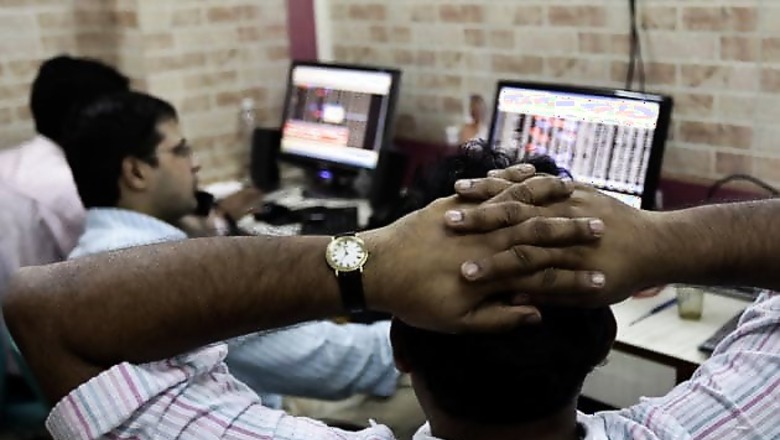
views
Mumbai: Testing times are ahead for equity investors serious about investing in Indian equities. With credit ratings agency Fitch revising our outlook to 'negative', sentiment has turned sour, not just on a slew of weak economic data but also due to policy inertia and allegations of corruption by the very people we elect to power.
But whatever the news, traders continue to have a long bias on the market right now. Market analysts like Sudarshan Sukhani of s2analytics.com has long positions in the Nifty and the bank Nifty. His advice to investors? Go and buy because this is a market that is in an uptrend.
The 30-share BSE Sensex rebounded quite sharply in the last hour of trade even after a downtrend in global markets. Banks, capital goods and FMCG took the lead in driving the benchmark index to close at 17,032.56 on Thursday. The Nifty was up 44.45 points at 5,165.
The momentum for economic reform has slowed recently even as senior Indian policymakers say they are committed to liberalising the economy and pushing a market-oriented growth strategy, says a report from Standard & Poor’s.
On the plus side, investment bank JPMorgan upgraded Indian equities to "overweight" from "neutral," lending a helping hand in pushing Indian equities higher. The rating was based on a number of factors including historic valuations, expectations for monetary stimulus, lower oil prices, and a weak rupee.
But Sukhani is unsure when the breakout will come. “We know we were in a trading range and this trading range was going to either breakout on the upside ore breakdown on the downside and the bias was bullish so we were positioned only for an upside breakout by being long,” he says, adding, that that what is predictable is that this move is going to come but the time is unpredictable.
Dilip Bhat, joint managing director, Prabhudas Lilladher finds that despite all the negative news our market has gone through, it still seems to be surging ahead for now. But going forward he continues to remain apprehensive. “Maybe this rally can take the Nifty up to 5,300-5,400 which is a possibility, but fundamentals still remain an area of great concern.”
Linked to fundamentals is corporate earnings growth which continues to look very anemic. Valuations in his opinion are not really cheap at the moment either. Bhat thinks at best it’s a pick and choose market or otherwise in a slightly longer run maybe eight to 12 months we will probably see market coming down significantly lower than 5,000.
The Nifty’s dip that he sees below the 5,000 level is predicated on negative global and domestic factors. “My basic contention is that a low GDP growth of around sub-6% will lead to a very weak and anemic corporate earnings growth. Until that improves, the market will still be muted at current levels or possibly seek a lower level,” he adds grimly.
Greece Results, FOMC Done. What Next?
After functioning without an elected government for 224 days, Greece has sworn in a new pro-euro currency government on Thursday. The debt ridden nation's new Prime Minister Antonis Samaras is preparing to name his coalition government to take on the uphill task of renegotiating the terms of an unpopular EU-IMF bailout.
The FOMC meeting is now behind us with no talks of stimulus from the US Federal Reserve even after the Fed indicated weaker growth prospects for the American economy. The next big trigger is the EU summit that takes place at the end of June. But don’t bank on the EU or the ECB flexing its muscles anytime soon, says Jeff Chowdhry, head of emerging market equities, F&C Investments.
“Even though global markets are expecting something, history shows us there has been a lot of talk and very little action. It’s probably very unlikely that something will happen in a meaningful sense,” says Chowdhry.
Compared to its emerging market peers, Chowdhry finds India well stacked up. “First of all sentiment has been very negative and the market and rupee has been very weak. Secondly the euro price is coming down which is very good news. For the market to become much more attractive and much more aggressively bought by FIIs, we need some policy responses and if we see some more approvals coming through that will be very positive for the market,” he adds.
Rupee: Relentless Fall Factors
Falling for the fourth-day today, the rupee tumbled to a new low of 56.57 against the dollar on increasing capital outflows from equity markets and rising demand from importers. The Reserve Bank of India made what traders described as a ‘mild’ attempt at defending the currency early in the session.
The RBI has been smoothing out the flow by selling between 56.40-56.50, says Agam Gupta of Standard Chartered Bank.
Since the day of the last credit policy, Gupta finds that the dollar-rupee has been in an uptrend. His outlook is that 56.25-56.50 is a very crucial level. “If this level breaks there is further upside but looking at global factors, there is not so much reason for this to break which is why we have come down from 56 now to 56.35."




















Comments
0 comment